- - GS820
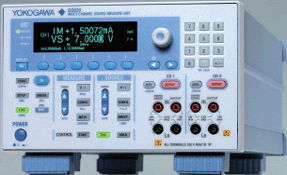
ISOLATED 2-CHANNEL SOURCE AND MEASUREMENT FUNCTION
제조사 : YOKOGAWA
제품명 : MULTI CHANNEL SOURCE MEASURE UNIT
제품번호 : GS820
제품분류 : 신호발생기
제품상세정보
|
 2-channel display example
(256 x 64 dot matrix display) |
Source and Measurement Range
Four-quadrant operation consisting of source operation (current source) and sink operation (current sink) is available with ranges up to 7 V and 3.2 A or 18 V and 1.2 A. The output and measurement resolutions are 5.5 digits.
|
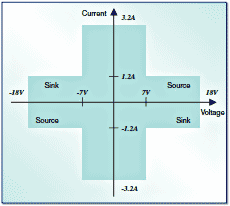 |
Functions
GS820 Construction and Functions
The GS820 is equipped with two analog channels with each channel consisting of a constant voltage source VS, a constant current source IS, a voltmeter VM, and an ammeter IM.The two source measure channels are isolated.
Source and Measurement Functions
Allows voltage sensing of a two-wire system or four-wire system by switching between local sense and remote sense. |
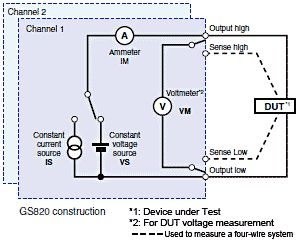 |
Combination of Source and Measurement Functions
The combination of the source and measurement functions of two channels allows the testing of various DUTs.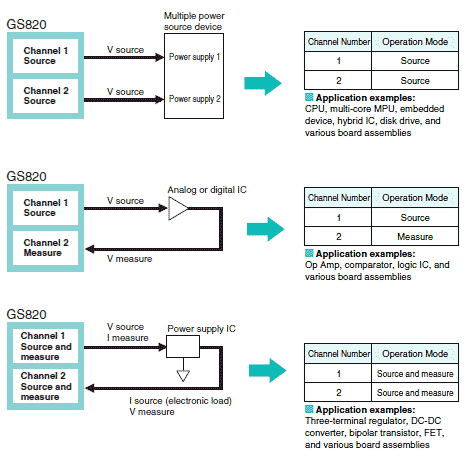
Source and Measurement Timing
Basic Source Measurement Timing
The GS820 performs generation and measurement using its internal timer or a trigger input such as an external input signal. When a trigger signal is received, the GS820 starts generating a signal after the source delay time elapses and carries out a measurement after the measure delay time elapses over a given integration time. The measurement integration time can be set in the range of 0.001 PLC to 25 PLC.*² Additionally, the GS820 provides an auto zero measurement function, which measures the internal zero reference after the measurement and performs offset correction in real-time. The integration time of the auto zero measurement is equal to the measurement integration time setting.

Timing Settings Using Various Trigger Sources
The GS820 allows the generation trigger source and measurement trigger source to be set separately. There are two types of constant period timers and an external signal input that can be used for the generation trigger source. In addition to these sources, source change point and sweep end point can be used for the measurement trigger source. Because the source trigger and measurement trigger can be set separately and also separately for each channel, source and measurement under various connection conditions and timing combinations can be accommodated. There is also an auxiliary trigger that can be activated using an external signal or a program event. The source delay, measure delay, and integration time can be set separately for each channel.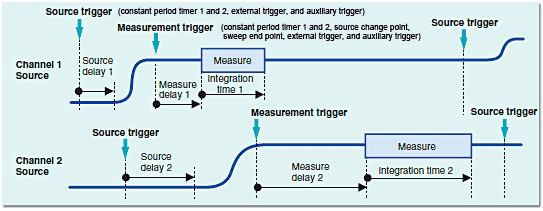
Asynchronous Operation of Source and Measure
The various trigger sources available on the GS820 allow the source and measurement to be executed asynchronously. The fi gure below shows an example in which separate timers are used for the source and measurement to achieve multiple measurements in a source cycle.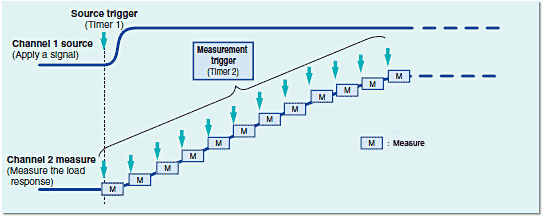
Sweep Function 1
Preset SweepThe voltage/current generation block of the GS820 operates in DC generation mode or pulse generation mode. Each generation mode has preset operation modes such as continuous output, linear sweep, and log sweep that allow the user to perform sweep operations by setting simple parameters. The output level can be changed at a minimum of 100-µs intervals*¹ in each sweep mode.
*1: Minimum program cycle
100 µs: If the measurement function is OFF
500 µs: If the measurement function is ON, two channels are used, and auto zero is OFF
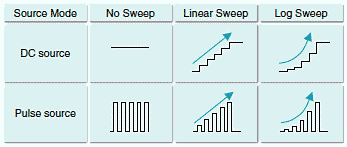
Sweep Function 2
Arbitrary Waveform Generation of Up to 100,000 Points and Simultaneous Sweeping of Control ParametersIn addition to the preset sweep functions described above, the GS820 is equipped with a programmable sweep function that allows the user to defi ne the sweep pattern. A user can create or edit arbitrary waveform data (CSV format) of up to 100,000 points using a spreadsheet or text editor. The GS820 is also of capable of sweeping the timing and control parameters in addition to the source level. This allows a control sequence that is synchronized to the waveform generation timing. The sweep program can be changed at a minimum of 100-µs intervals*¹ in programmable sweep mode.
*1: Minimum program cycle
100 µs: If the measurement function is OFF
500 µs: If the measurement function is ON, two channels are used, and auto zero is OFF
The values do not include the hardware operation time corresponding to the control parameters.
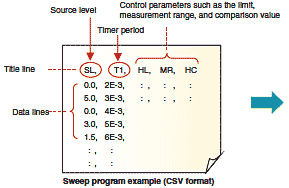
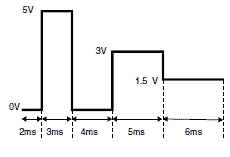
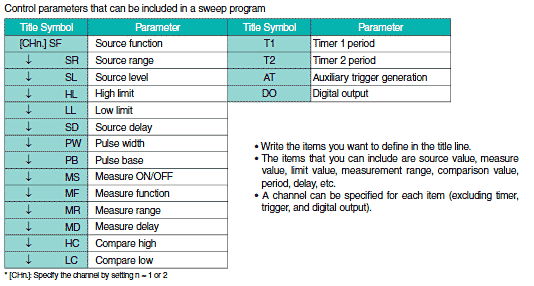
Test Sequence Editing
(Application to Auto Testing Equipment)The GS820 allows the editing of test sequences suitable for auto testing on the production lines. A user can write program fi le parameters that are vital to auto testing such as the source value, measured value, high limit for comparison, low limit for comparison, comparison result, control bit output, etc. Because the program fi le is in CSV format, a popular spreadsheet application can be used to edit and view the program.
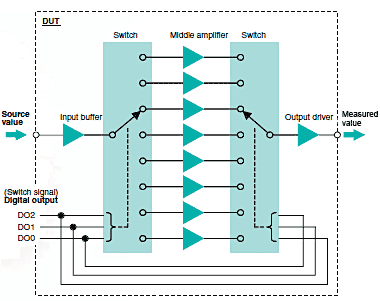
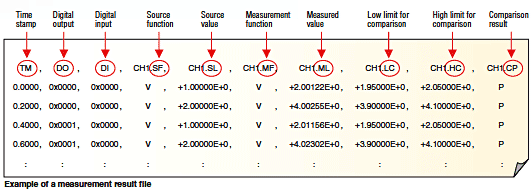
Test Speed
Improvement in the Takt Time in the Production Line TestThe GS820 provides fast operation for production line tests. The measured results of test speeds (reference data) are indicated below.Measured values of test speeds (reference data)*¹
| Task | Operation Time | Command Used | Conditions |
| Change the source level (1 channel) |
423 µs |
:chan1:sour:lev 15.0000 | Measurement function OFF source range fixed to 18 V. |
| Change the source level (2 channels) |
910 µs |
:chan1:sour:lev 15.0000 :chan2:sour:lev -0.12500 |
Same as above |
| Change the range and source level |
978µs |
:chan1:sour:rang 18V lev 15.0000 |
Measurement function OFF |
| Change the limiter and source level |
1,048µs |
:chan1:sour:lev 15.0000 prot:lev 200µA |
Measurement function OFF, source range fixed to 18 V. |
| Switch the source function |
457µs |
:chan1:sour:func volt | - |
| Measure (1 channel) | 613µs |
:chan1:meas? | Integration time 0.001 PLC, auto zero OFF, and external trigger OFF. |
| Measure (2 channels simultanesoully) |
820µs |
:meas? dual | Same as above |
| Change the source level and measure (1 channel) |
985µs |
:chan1:sour:lev 15.0000 :chan1:meas? |
Same as above, source range fixed to 18 V. |
| Change the source level and measure (2 channels) |
1,686µs | :chan1:sour:lev 15.0000 : chan2:sour:lev - 0.12500meas? dual |
Same as above |
*1: Measurement environment
Core 2 Duo processor 2.33 GHz, USB2.0, using LabView
Channel Expansion
Expansion up to 10 Channels Using the Master-Slave OperationMultiple GS820s can be connected as shown below and used as a multi-channel source measure unit. The master-slave feature allows the program data of all connected channels to be set and collected by simply accessing the master unit. The master unit (1) distributes the source data to the slave units or (2) collects and merges the measured data of all slave units. Complete synchronization of all channels can be achieved by connecting the exclusive trigger signal line.
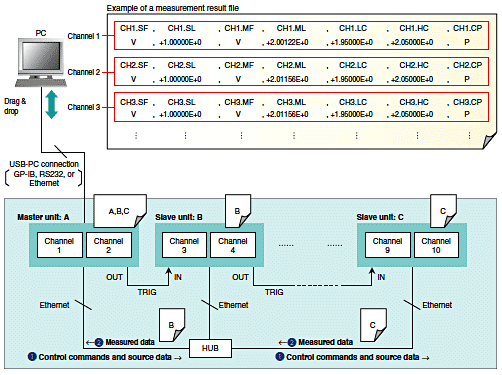
Zero Generation Function of Voltage and Current
Fast Load Disconnection without ChatteringThe zero generation function of the GS820 generates zero voltage or current as well as controls the current/voltage limiter to limit the load current. The GS820 stops applying the voltage or supplying the current to the load in the zero generation state allowing the DUT to be disconnected with the output relay turned ON. This function avoids the problems of chattering and contact life of the output relay and reduces the time for turning ON/OFF the output.
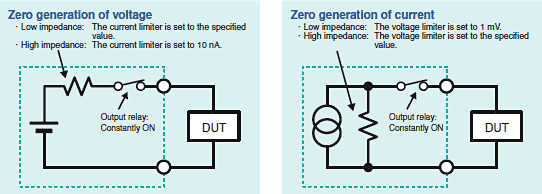
Model Numbers
| Model | Description |
|---|---|
| 765602 | GS820 Multi Channel Source Measure Unit Digital I/O Installed Model |
| 765601 | GS820 Multi Channel Source Measure Unit Standard Model |
Application Notes
| Name | Description | |
|---|---|---|
| Power Conversion Efficiency Measurement of Power Supply ICs | Power Conversion Efficiency Measurement of Power Supply ICs | Learn More |
| Measurement of the Static Characteristics of Three-Terminal Semiconducter Devices (Transistors, FETs, etc.) | The GS820 can measure drain current ID by applying gate-source voltage VGS from channel 1 and drain-source voltage VDS from channel 2. | Learn More |
| Timing Tests at Power-On of Multiple Power Supplies | Timing Tests at Power-On of Multiple Power Supplies | Learn More |
| Measurement of I/O Characteristics of Semiconductor Devices | Measurement of I/O Characteristics of Semiconductor Devices | Learn More |


제품정보
● 2채널 소스와 측정 기능 절연 되어 있습니다.
● 소스와 측정 레인지 : 7V AND 3.2A OR 18V AND 1.2A
● 小-전류 레인지 : 200NA OR 1PA RESOLUTION
● 100ΜS 인터벌에서 100,000 포인트 이상으로 구성하여 파형을 발생시킵니다.
● MASTER-SLAVE 링크 조합을 통하여 채널 확장
● 초-고속 검사 스피드
● 16비트 디지털 I/O(모델 76502)